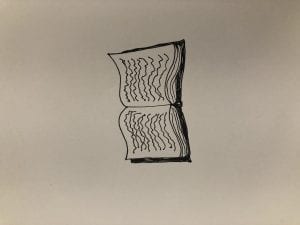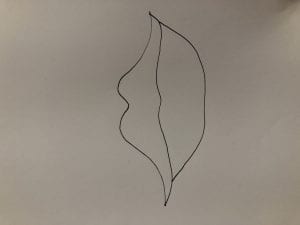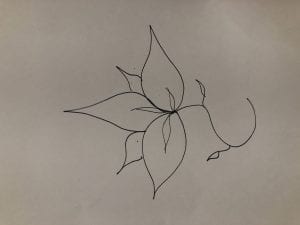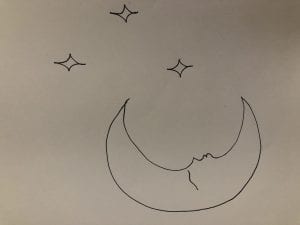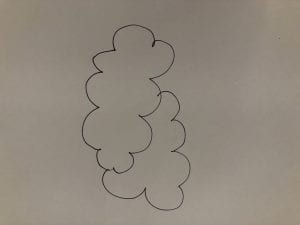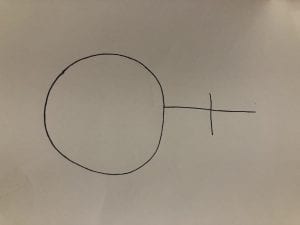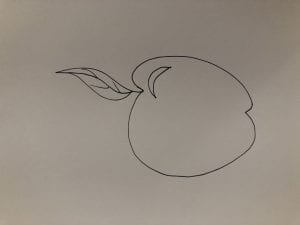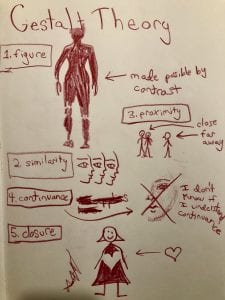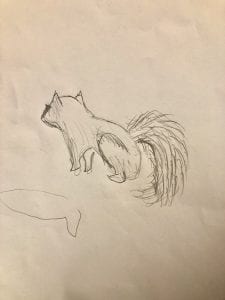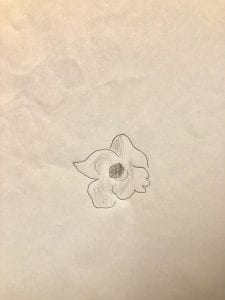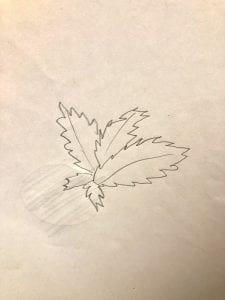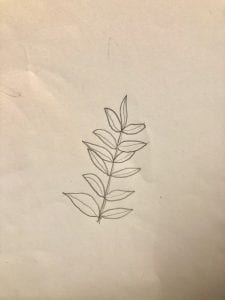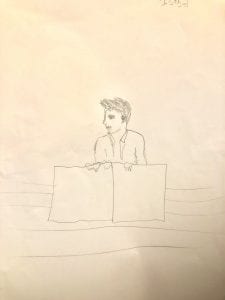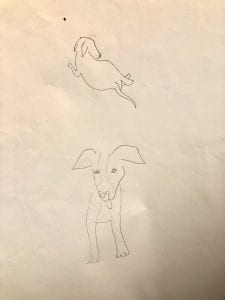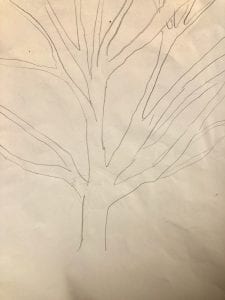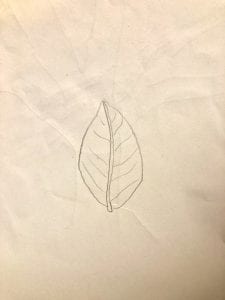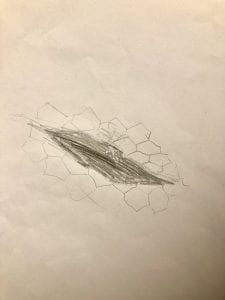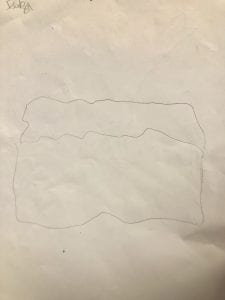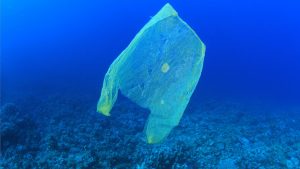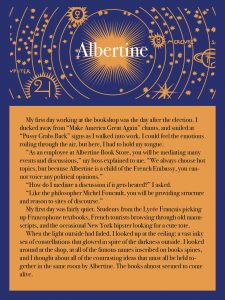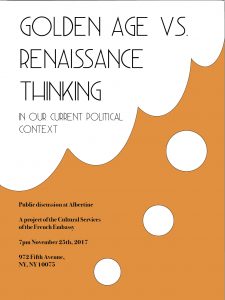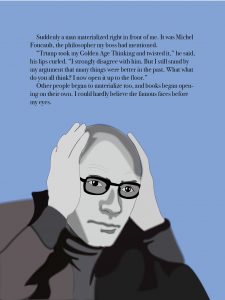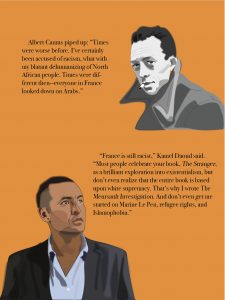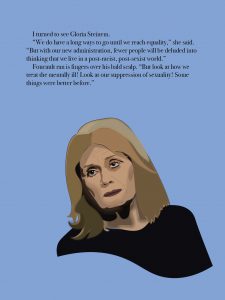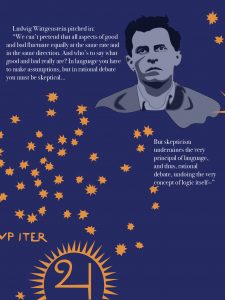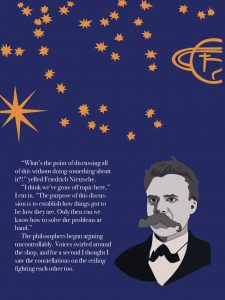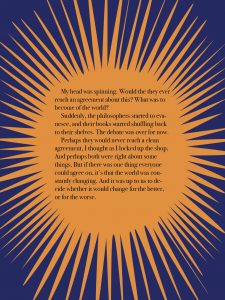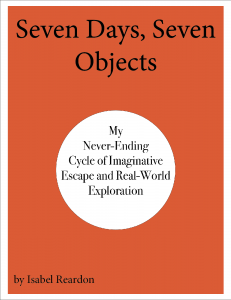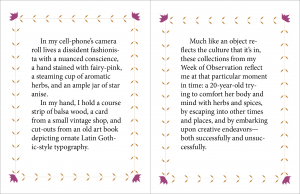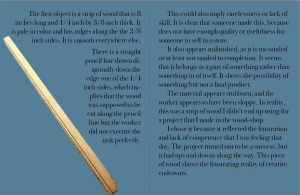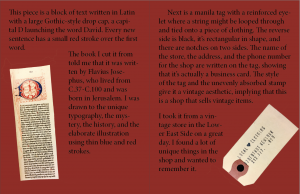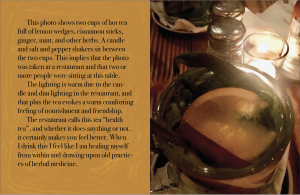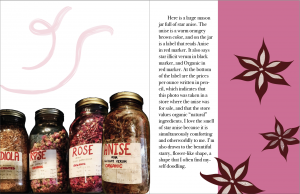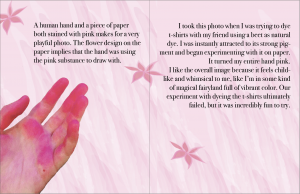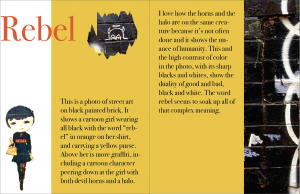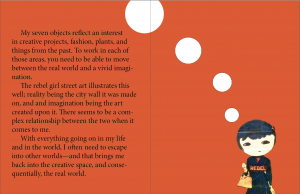I didn’t realize I had to put this online because we presented this in class. Here is what I presented in class:
Category Archives: Uncategorized
Gestalt Theory
Design Lab: 01 Shape
Space and Materiality Final Project Reflection
Every year, at least 8 million tons of plastic are dumped into the ocean. That plastic gets digested by sea animals, gets stuck or tangled around their bodies, or it just sits there in the water emitting toxic chemicals. A lot of trash travels in the ocean and settles into “gyres”, or, ocean garbage patches, trapped by currents. Thus, large amounts of plastic, chemical sludge and other debris end up in the same places, making essentially islands of garbage. Soon the whole world could look like this.
For our final project in Space and Materiality, my group and I decided to make a globe out of plastic. We used recycled plastic bags from our own consumption to form the world’s continents. Our idea was to show the excess of plastic that we produce and throw away, and that we can actually use some of our trash to make things. We wanted to give our trash a second life.
However, for aesthetic’s sake, we decided to use Party City blue tablecloth plastic to resemble the oceans. I felt really conflicted about this, because it’s just encouraging more plastic being bought and thrown away, but under the time allotted it seemed like the only option for an aesthetically pleasing end product, which we all wanted.
The presentation of our project led to a lively debate amongst the group. Should we blow up our globe in a park, or a waterway to hint at the garbage islands? That seemed like it would just be adding to the problem. So we decided to blow it up from inside of a trash can, with other pieces of trash around it, as a dark commentary on the future of our world.
After we came up with the concept, I drew outlines of the continents on Adobe Illustrator and scaled them up mathematically. We then printed them out, tracing the shapes onto the plastic fabric. I also spent a lot of time ironing the plastic bags we collected into fabric, as well as collecting bags, cutting out continents, buying and bringing other tools we needed, discussing the presentation, and doing research on our issue.
I really enjoyed this project because the craft is so hands-on and intuitive, and it allowed me to seriously consider how harmful plastic really is to the ocean, to the air, to animals, and to ourselves. How can we decrease the amount of plastic we acquire and dispose of? How do we dispose of it properly? I learned that most of the plastic we throw in the recycling bin doesn’t even get recycled, including plastic bags. Now that I know that we can use our trash ourselves, I will be thinking a lot more critically before I purchase and before I throw away; Maybe there is a lot more art to be made from recycled garbage.
Creative Work #2: Mask for the Anthropocene
I made a mask out of recycled newspaper in the shape of a seed to represent a seed of true democracy. This mask was inspired by an experience I had in Istanbul where I got caught up in protests to save a park—that larger issue was about saving true democracy in Turkey. I was teargassed by the police and the protesters were so kind to me and helped me treat my eyes. They told me never to wash my eyes out with water, but instead to do it with milk or seltzer. Thus, I painted tears of milk below the eyes of my mask. They then said to put lemon juice under and below my eyes, so I painted lemons above the eyes on my mask. The background of the mask is teargas as well as newspaper to symbolize the political impact of the protest. The mask didn’t turn out the way I wanted it but it is meaningful to me because of all of the symbolism behind each choice I made. When someone puts this mask on, they are prepared to save the world one peaceful protest at a time.
Project Statement / Artist Statement
For my final project I made bustiers inspired by previous projects and experiences, as well as my rising interest in fashion and the dark underbelly of fashion industry. Alongside that, I wrote a research paper for Seminar attempting to show the value of transparency and local engagement in the fashion industry, through my interpretations of the visual culture of three fashion labels.
The bustiers use symbolism to address ocean pollution, capitalism, colonialism, genetic modification, and female beauty standards. I aim to critique, while hopefully galvanizing and encouraging people to learn about and act on important issues. They are simultaneously personal to me, and relevant to the world. They are all made from recycled plastic and soda cans to remind people of pollution and consumerism and to show people that we can use some of our trash instead of piling into landfills. In my research paper I explore the harmful effects of the fashion industry, including the 2013 Rana Plaza factory collapse, different types of pollution, dangerous working conditions, and damages to local economies.
Each wearable statement has a different texture, material, cut, and message, but they all explore the intersection between design and activism; two fields that desperately need each other. Activism and creativity are my inspiration for almost all of my projects. I see works similar to my line of bustiers by Slow Factory, a company that I discuss in my research paper.
These bustiers work with the female body and the environment around it. I creative-directed a photoshoot at Coney Island, with photographer Katie Comfort and model Klara Nilson. I chose the setting and backgrounds carefully to relate to the issues each piece speaks about, and to overall evoke nostalgic Americana and consumerism.
Ultimately I want my pieces to draw in the eye, and with it, the mind. With both my seminar research paper and my studio project, I want people to think critically about what they’re putting on their bodies, and the effect is has on the world around them.
Project Proposal
In seminar I will be examining how fashion and business should incorporate ethics and activism to create a better world, and in Studio I will be putting this into reality by creating my own ethical line of garments. My imaginary company, Radical Empathy, will use sustainable materials and careful thought to create political statements through wearable art. Imaginary profits from each piece I make would go to the topic they’re each about.
More specifically, I will be releasing two bustiers using plastics that we are dumping into the ocean. I have collected plastic bags from beaches, streets, and my own consumption, fuse them together to make fabric, and make bustiers out of the material. The first bustier will be ocean-themed; the cups will resemble seashells and will be made out of a blue and white marbled fabric that I have created, and below I will have white plastic-lace cut in a scalloped design to create the look of sea-foam. To go with this look, I will have a wrist cuff made from cut soda and beer cans, resembling fish scales and thus reminding people that this was made by humans, and of the tragic effect we have had on nature. That is my idea for the ocean bustier; to evoke the ocean with human-made materials that actually pollute the ocean in the attempt to make people think critically about what we’re doing to our planet.
The second bustier will be in a colonial “stay” style, with tie-on sleeves. The fabric will be white fused with slogans and words from plastic bags I have collected, showing that capitalism is all around us. I want to show both the earlier times of colonialism and our current day capitalism, provoking the wearer and viewer of my piece to think about how the two connect. One of the slogans on a bag I found says I have says “I just HAD to have it!”, which could refer to both consumerism and the desire to occupy territory. Capitalism and things leftover from the colonial era are all around us, and can trap us in a suppressing society—much like a corset traps a woman’s body. With this look will be a colonial-style “mitt” made from white plastic-lace and clear plastic.
This project is about taking something unwanted and unsustainable, and reversing that. Each garment I make must spark conversation, raise awareness about an important issue, be aesthetically pleasing, wearable, and be sustainably manufactured. I envision customers wearing my garments to parties and events—places for conversations. I want people to see my work and ask what is is and what it means, sparking discussions about the cause and thus raising awareness and building empathy.
Integrated Studio 2: Bridge 2
In Integrated Studio 2 we had to choose a location from https://www.atlasobscura.com/things-to-do/new-york and build a project around it, incorporating into it an element of personal, public, historical, and fictional. I chose Albertine, a francophone-anglophone bookstore right near the MET, across the street from Central Park.
First we conducted preliminary research, and came up with 25 interview questions about our chosen site so we could narrow them down to just a few. Then we each visited the location itself, taking notes on sites, smells, and any type of observation that came to mind. I interviewed three people—two employees and one customer.
I was most intrigued by what one of the employees said about the debates that they held, how they provided structure and logic to sites of discourse, following the philosophy of Michel Foucault. When I asked him about political associations with Albertine, he froze up a little and told me that they are supposed to remain neutral because they are an extension of the French Embassy.
As I looked around the bookstore, I was enthralled by all of the ideas that have travelled here through books and the people reading them. I remembered the heated discussions the employee was talking about Albertine hosting, and I began to wonder: if books could talk to each other, what would they say?
I formed a short story around this idea, writing from the point of view of an imaginary newly-hired employee at Albertine, and placing it in the context of our current political climate. In the story I reference Donald Trump and Marine Le Pen, and I brought to life the books of several famous philosophers and writers whose titles I found in the bookstore. I illustrated my story using Adobe Illustrator and lay it out in InDesign.
I drew inspiration from the stunning constellations painted on the ceiling of Albertine, and the golden glowing lamps that hung throughout the rooms. I decided that my color scheme would be night sky blue, golden yellow, and light blue. I drew all of the dead people in the story in black and white, and all of the alive people in color. I wanted to create a dreamy fantastical aesthetic full of intricacies and attention to detail, to mirror the ideas brought up in my short story.
During the critique I dropped the pages and watched them flutter onto platform. “This is a deconstructed book,” I said, “but I will lay it out for all you to read.” I arranged the pages in order on the platform and we all stood over it as different classmates took turns reading aloud. This allowed for everyone to see the design and layout of the whole thing and notice the color scheme and how the pages interacted together. The symbolic reason that I chose to have it deconstructed was because I felt that it matched the theme of the story and the concept of books flying out of their shelves and people materializing from them. If I were to do this again I might think of another way to display it that is more clearly a deconstructed book. For example, I could have made it into a book first and then torn the pages out.
Podcast Inspiration
The fashion industry pollutes and detriments human rights more than almost any other industry. This is why Céline Semaan Vernon, the launcher and creative director of Slow Factory, a slow fashion-activism company, and fashion-writer Nadine Farag, launched the podcast WEAReSLOW.
WEAReSLOW sparks an open dialogue about activism and sustainability in the fashion world. Their goal is toto include, not exclude, people from this dialogue, taking into consideration global intersectional feminism, racial justice, maternity issues, refugee rights, and the socio-economic differences of people all around the world.
Nadine and Celine use facts from articles, journals and studies to support their arguments, as well as their own experiences and the experiences of the vast communities around them. I do the same, and my opinions line up with the opinions expressed in the podcast. I also identify with them personally; not only are they politically active creative-types and activists, but they have connections to other countries and feel one with the refugee crisis. I can relate to this as an artist/activist who has lived all around the world and spent a lot of time working at a refugee camp, forging close friendships and relationships with the residents. I chose this podcast because Slow Factory holds a place in my heart, and WEAReSLOW is an audible extension of that. It aligns perfectly with my research question, “How Should Activism Intersect with Wearable Art?”.
Their link is attached below:
http://weareslow.co
Seven Objects, Seven Days
I collected one object from my day for one week. I thought I was choosing things randomly from my days, or things I liked, but the objects together and alone said a lot more about me than I thought they would.
I struggled with InDesign, as it was my first time using it and I experience a lot of glitches. But I learned a lot about the program, and I was able to learn about graphic design and illustration as well. For this project I used Adobe InDesign, Illustrator, and Photoshop.

